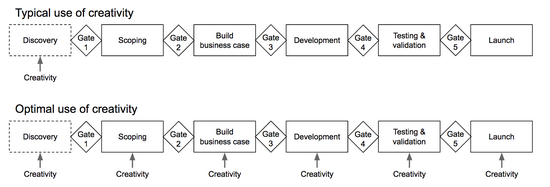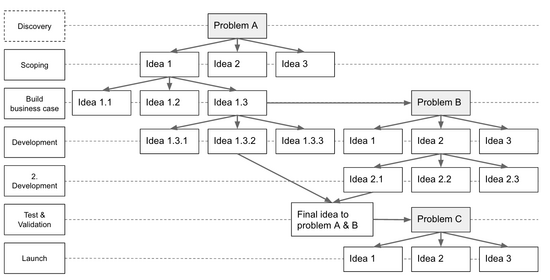Creativity as a Practice in Projects
Contents |
Introduction
Creativity is when something novel and relevant is created. It can be everything from a joke, clay model or food recipe to something more business oriented – new product, process or strategy. Notice that creativity is not only creating something new or unique, but just as important, it should be relevant and appropriate for a given problem or situation [1]. This last notion is what often is referred to as innovation, new ideas that bring value [2]. This article focuses on the topic of creativity used in organizations, and more specifically projects, programs and portfolios. Creativity is what typically fosters the non-standard, imaginative and original solutions to a problem. It is therefore by its nature highly valued by managers and organizations, as it can solve the unsolvable problems and bring competitive advantage.
Advantages & Disadvantages
Creativity has a set of advantages and disadvantages. The advantages can be divided into team level and organizational level.
Advantages at team level
The following benefits the team, assumed that the creative process is handled professionally and appropriately. Creativity can work as a teambuilding exercise. Creativity is happening on a conceptual level, and therefore everybody is able to participate. As everybody can participate, the team develops, and everybody can see his or her contributions to the progress. Working creatively is also rewarding in itself, since generating ideas is making a feeling of fulfillment. Creative processes is also able to open op the minds of more “closed” analytically team members. Leverage of knowledge and experience is also often a benefit from a cross functional creative team.
Summary:
- Building emotional involvement
- Generating new ideas
- Increasing teaming
- Leveraging and increasing knowledge
- Opening minds
- Stretching the performance of people
Advantages at organizational level
The advantages of the organization is directly linked to competitive advantages. Organizations environment, competitors, markets etc. is experiencing an accelerating rate of change, and thus reacting quickly and working with novel technologies requires a high level of creativity. As the environment is in rapid change, it is also getting increasingly complex, and while complexity requires highly analytical skills, the problem solving requires creative skills. The society is becoming more globalized. Globalization both poses a threat, as well as a new field/option to work with creatively.
Summary:
- Accelerating rates of change
- Rapid technological change
- Increasing complexity of the environment
- Globalization of business competition
- Transition from industrial to knowledge-based society
Disadvantages
The disadvantage of creativity is that it challenges the current situation and progress of the project. A project can take a completely unexpected turn during creative process. Creativity also challenges the authority, by definition you need to neglect authorities when working creatively. Both of the mentioned disadvantages can cause anxiety and dissatisfaction within the project team. From a manager’s viewpoint, creativity can also be a very inefficient way of operating, since it requires a lot of time and most of the experts. And while it is a very costly process, it is, as mentioned earlier, a very unpredictable process and therefore valuable take-away is not guarantied. This last disadvantages is the main reason why creativity is not seen as much in projects as it could be.
Summary: *Cause of anxiety
- Challenge authority
- Upset team
- Upsetting the status quo
- Waste of resources
Creativity in project, program and portfolio management
Creativity at organizations Creativity is often perceived as the initial phase of a project. After the initial part, all preceding steps is clear defined steps
Creativity is a key ingredient in the success of almost all projects simply because projects rarely go as smoothly as planned. Obstacles, issues, risks, and showstoppers are just some of the debris that falls in the path of completing a project. This debris requires that people be creative in dealing with it so that the product or service being built and delivered meets the needs of the customer. This creativity can happen both on individual and group levels; ideally, the levels should be integrated in a way that melds the creativity of the individual with that of the group to increase the likelihood of the successful completion of a project.

